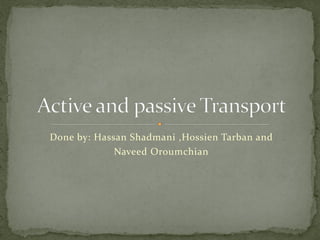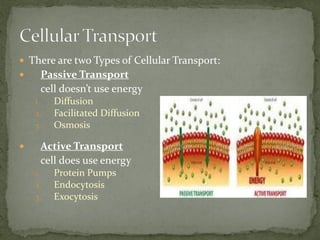Cellular Transport (Active and Passive transports
- 1. Done by: Hassan Shadmani ,Hossien Tarban and Naveed Oroumchian
- 2. ’éŚ There are two Types of Cellular Transport: ’éŚ Passive Transport cell doesnŌĆÖt use energy 1. Diffusion 2. Facilitated Diffusion 3. Osmosis ’éŚ Active Transport cell does use energy 1. Protein Pumps 2. Endocytosis 3. Exocytosis
- 3. ’éŚ In passive Transport the cell uses no energy . ’éŚ Molecules spread out from an area of high concentration to an area of low concentration. ’éŚ There are three types of passive transport: ’éŚ Diffusion ’éŚ Facilitated Diffusion ’éŚ Osmosis
- 4. ’éŚ Diffusion: movement of particles from an area of high concentration to an area of low concentration. ’éŚ Diffusion continues until all molecules are evenly spaced (equilibrium is reached).
- 5. ’éŚ Facilitated diffusion: diffusion of specific particles through transport proteins found in the membrane. a. Transport Proteins are specific ŌĆō they ŌĆ£selectŌĆØ only certain molecules to cross the membrane b. Transports larger or charged molecules.
- 6. ’éŚ Osmosis: diffusion of water through a selectively permeable membrane. ’éŚ In osmosis water diffuses from a hypotonic (low solute concentrated) solution to a hypertonic (high solute concentrated) solution
- 7. ’éŚ In active transport the cell uses energy to transport particles. ’éŚ Movement is from an area of low concentration to an area of high concentration. ’éŚ There are three types: 1. Protein Pumps 2. Endocytosis 3. Exocytosis
- 8. ’éŚ Protein Pumps -transport proteins that require energy to do work. ’éŚ Example: Sodium / Potassium Pumps. Protein changes shape to move molecules: this requires energy
- 9. ’éŚ Endocytosis : taking bulky material into a cell ’éŚ Cell membrane in-folds around particle ’éŚ Membrane changes shape to allow the particle to pass. ŌĆó This is how white blood cells eat bacteria.
- 10. ’éŚ Exocytose: Forces material out of cell in bulk. ’éŚ membrane surrounding the material fuses with cell membrane ’éŚ Cell changes shape to guide the material out the membrane. ŌĆó EX: Hormones or wastes released from cell










